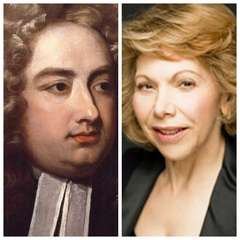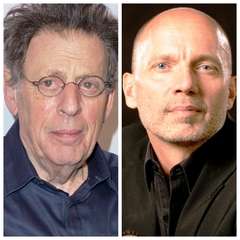|
Back
Ya Pays Your Money and Ya Takes Your Chants New York
Leonard Nimoy Thalia, Symphony Space
02/18/2019 -
Maria Newman: Pennipotenti [1]
Traditional Byzantine Chants: Osi is Hriston – Simeron Kremate – Einite ton Kyrion [2]
Victoria Bond: Simeron Kremate (New York Premiere) [3] – The Adventures of Gulliver [4]
Philip Glass: Piano Quintet “Annunciation” [5]
Michael Kelly (Baritone) [4], Ariadne Graf (Soprano) [4], Sean Christensen [4], David Charles Tay [4] (Tenors), Yoojin Lee (Mezzo-soprano) [4], Daniel Klein (Bass-Baritone) [4], Hal Ott (Flute) [1], Maria Newman [1, 5], Laura Hamilton [5] (Violins), Scott Hosfeld (Viola) [1, 5], David Geber (Cello) [5], Paul Barnes [3, 5], Marc Peloquin [4] (Piano), Victoria Bond (Interlocutor), Doug Fitch (Director) [4], Archdiocesan Byzantine Choir, Demetrios Kehagias (Conductor) [2]

J. Swift, by Charles Jervais/V. Bond
"Soon, with a noise like tambourines,
Came her attendant Byzantines...
And then the simpering Byzantines
Fled with a noise like tambourines”
Wallace Stevens: Peter Quince at the Clavier
Methinks Wallace Stevens never heard Byzantium music. For when the Byzantines weren’t making war, acquiring and losing territories from the Atlantic to the Black Sea, when the Emperors weren’t massacring their populace in the great Hippodrome, when they weren’t history’s most monumental place of worship...then Byzantium, forsaking Rome’s Gregorian Chant, was creating their own music in the 12th Century.
None with tambourines.
Those chants predominated the first half of last night’s eclectic (and ecumenical) concert in Symphony Space. First, the original chants, sung by a Greek Orthodox a.k.a. Byzantine choir. Then a rhapsodic piano work for a chant by Victoria Bond. And Philip Glass’s “Annunciation” Quintet, which was Orthodox–but for Mr. Glass, highly unorthodox.
The evening was three hours long. But so diverse were the selections that one never felt the slightest fatigue. In fact, the opening work by Maria Newman would wake up the most somnolent visitor. Pennipotenti was a musical picture of four birds, written for three treble instruments, violin (played by the composer), flute and viola.
These, though, were neither Messiaen metaphysical/mystical birds or avian imitations. The trio started with a 17th Century-style overture before going into a soaring “dipper”. For an owl, she understood the so-soft hoot with some pianissimo harmonics, over modal harmonies. This was followed by a square-dance scurry for the humming bird. The longest section was for the falcon. No cute little birdies for Ms. Newman. She knew the predatory raptor, and her aural vision varied between grace and menace. A gorgeous start.
Magically, the following 14-man Archdiocesan Byzantine Choir was not a jolt, but a complement. From the upper voices of Ms. Newman’s instruments, we had the lowest voices in the register. These were not Gregorian chants, which gestated in the same 12th Century. This liturgy was distinguished by the pedal points in the deepest bass, with archaic harmonies with songs of the earth which later dominated music from Mussorgsky and Borodin up to Glière and Shostakovich. True, it was unusual to see such a choir in Symphony Space, yet the effect was mesmeric–and an inspiration to the next two works.
“Inspiration”–meaning, of course, the “inhalation of the Divine Spirit” Victoria delights in diverse musical styles here. Her Simeon Kremate could have been called titled “Rhapsody on Two Ancient Liturgical Hymns”. First was the titled Greek Orthodox chant for the Crucifixion, a song of praise. The other–with the same tonal pattern, the same implied harmonies–was a Jewish Passover chant called Tal, Hebrew for “dew”. Both, wrote Ms. Bond, were reflections on the “gift from God.”
Even more extraordinary, Ms. Bond realized, is the parallel of the Crucifixion taking place on Passover Week, so that Jesus, leading that Seder, could well have been singing the Tal.
Paul Barnes was the soloist here, giving an exciting performance (he is a most visceral player!) for a rhapsody on the two works. The music had no particularly religious flavor. With feet barely off the pedal, the work had a Romantic feeling, sometimes sounding like cembalon, more often with those harp-like arpeggios which expanded the original melodies.

P. Glass/P. Barnes
That was a flight of fancy. Next, introduced by Ms. Bond, Mr. Barnes and composer Philip Glass, was a more literal flight. The two men had met on an airplane, both affirmed their adoration for Greek Orthodox music, and for almost a quarter-century, had retained both a friendship and later a commission for Mr. Glass to compose his first Piano Quintet.This was based on the Byzantine chant for the Annunciation of Mary, when told by the Angel Gabriel that she would give birth to the Son of God.
After six decades of music by Philip Glass, one inevitably faces a new work with trepidation, that his trademark ostinato patterns might overwhelm his inspiration. The Quintet was different. The structure, involving the original chant, was complicated, Mr. Barnes did exercise those ostinati. Yet one had the feeling that Philip Glass was just an old Romantic at heart. We had moments in these two movements that were pure Brahms, we had a cello solo which could have introduced some Dvorák, we had, in other words, a beautiful, gracious, endlessly lyrical chamber work. In fact, one of his monumental works.
After this somewhat sacred first half, we turned to an opera by a man who–while the Dean of a church–was very much an 18th Century doubter, Jonathan Swift.
Not only a doubter of religion, but a man who detested music. (“He was a fiddler, and thus a rogue,” said Swift). So famed was his Gulliver’s Travels that his contemporary Georg Philipp Telemann wrote a delightful work with the same name (for two violins), and reportedly Dean Swift had no interest in hearing it.
Victoria Bond had no qualms about setting the impossible myths, since she had a very workable libretto by Stephen Greco. A fairly tall Sean Christensen was seen by faintly stooped Lilliputians. A stooped Mr. Christensen had singing by the Brobdingnags standing on chairs. It sounds plebeian, but actually worked.
Ms. Bond’s music, played by pianist Marc Peloquin, had a variety of styles. Least impressive were the domestic scenes, inevitably harking to Bernstein’s mock-18th Century Candide. The myths, performed by an ensemble as deft in acting as singing, were more inventive, fun, sometimes a bit maudlin at times, happily show-biz at times. Always jaunty and effective.
Okay, so one had satire, music, acting and delight. The acerbic Dean Swift might have asked, “Where, then, is my purpose? Where are the executions and beggars? Whither are my spears into the so-called civilizations of Europe?” Well...this is, after all, a comic opera. It ain’t politics and it certainly ain’t religion. Considering her restraints, considering that a Figaro comes but once in a thousand years, Ms. Bond’s Gulliver was a splendid endeavor.
Harry Rolnick
|